ACT
Australian War Memorial
After a very busy five-year period commemorating various First World War centenaries, the Australian War Memorial’s conservation staff are taking a moment to catch our collective breath and address all those routine jobs that have been neglected lately, before we plunge headlong into a major 10-year redevelopment of the Memorial’s main site and galleries.
In the Photos Lab, Joanne Lisinski and Maree Swan have replaced Ian Fulton and Yupa Nanteau respectively, who both retired last year. Long-term team member Thomas Fanning rounds out the team. The Photos Lab is currently treating and preparing all of the AWM’s small gauge films for digitisation (Standard 8mm and Super 8mm). This is an exciting project for our team as it is the first time we have worked on this material in the conservation department. To prepare, we liaised with the NFSA, NAA and our international colleagues to upskill our team. Great progress has been made and we have completed approximately 150 films to date. We are also currently working on safely conditioning films that have been frozen, and are about to start a program to digitise our extensive glass plate negative collection. Aside from digitisation, we hope to survey the condition of our glass plates and stabilise and rehouse any that are fragile or broken. We are also working on a vinegar syndrome survey and on strategies to isolate and encapsulate affected collections from healthy collections. In addition, the lab has recently purchased an iN10 and iS5 ThermoFisher Scientific FTIR. One of the main drivers for acquiring this instrumentation was to assist in the accurate, safe, and non-destructive identification of film bases; however, inherently there will be a wide application of its use, including assisting in the identification of: hazardous materials such as cellulose nitrate, explosives, fuels, pharmaceuticals and pesticides; general constituent materials such as pigments, paint binders, dyes and fibres; degradation products such as corrosion, metal soaps and fatty acids in paintings, and migrating plasticisers; and previous restorations such as those involving adhesives, waxes, coatings, and other non-original materials.
Eliza McKenna, formerly our Preventive Conservation Officer (PCO), has been seconded to the roll of Hazards Project Officer. This project is taking a holistic look at the hazards we have in our collection, and how we should address them. Jacqueline Jordan is acting as PCO in Eliza’s absence. Jacquie also recently won the Alexander Copland award for her Master’s thesis. We are very proud of her!
In the Objects Lab, Jacquie has been replaced by Bridie Kirkpatrick from the Textiles Lab. We are using Bridie’s secondment as an opportunity to do some professional cross-training. Clair Champion has been seconded to Registration to assist with loans for the up-coming Courage for Peace temporary exhibition. Lucy Dingwall is backfilling Claire. After three years of steady work, Andrew Schroeder and George Bailey have just completed the Radiation Mitigation Project, which involved identifying radioactive material in the collection and relocating the majority of it to dedicated storage areas. The project has been a very steep learning curve for us, and eye-opening with regards to what things are actually radioactive. We intend to publish some of our findings in the not-too-distant future.
In the Textiles Lab, Stefanie O’Grady has stepped in to back-fill Bridie’s position. The Textiles Lab recently passed a major milestone of the 3,000th flag to be properly rolled for storage, with many more to go.
The Paper Lab and Paintings Lab continue to process a seemingly never-ending list of loans and changeover works. With the federal election, the Paintings Lab is also on standby for a flood of changeover requests from Parliament House.
The AWM recently took possession of our new building in Mitchell, Treloar E, which is a huge clear-span building designed to accommodate our growing collection of aircraft. Movement of aircraft into the building has already commenced, and will continue apace for the next few months. The LTO Conservation team, consisting of Jamie Croker, Ainslie Greiner, Mark Aitken, Kim Wood, Dean Willis and Martin Tanti, have been largely preoccupied with preparing the collection for the move, including new acquisitions in Adelaide, Avalon, Nowra, Oakey and Sydney.
NSW
Art Gallery NSW
Frames
In April, the Art Gallery of New South Wales hosted FRAME: Concept, History and Conservation, Symposium 2, under the direction of Basia Dabrowa and the symposium committee. The event was a huge success that fostered exciting discussions around frames and welcomed speakers and guests from Australia, New Zealand, England, the United States, France, Poland, Germany and Canada. Congratulations to all involved, and we look forward to the next one.
The frames conservation department has seen the completion of two major projects by Margaret Sawicki and Grace Barrand: the late 19th-century Charles Landelle frame and the early 20th-century Sydney Long papier-mache frame. Loans and exhibition work is ongoing, as is the major restoration of the Cignani frame. We wish Basia well on her Long Service Leave, and look forward to her return in September.
Tom Langlands has been working on two reproduction Cetta frames for unframed Joseph Backler paintings recently acquired by the Gallery. The next step will be a visit to the State Library of New South Wales to look at ornaments in their extensive Backler collection.
Objects
Objects conservation was involved with activities associated with the condition checking and preparation of upcoming exhibitions, the taking down of previous exhibitions, incoming and outgoing loans and new acquisitions into the collections.
Kerry Head experienced some trepidation when handling and condition checking exquisite and rare Chinese antiquities belonging to the National Palace Museum, Taipei. In their previous lives only the emperors were permitted to touch them. The experience of working with colleagues from the Rare Books, Paintings and Antiquities departments of the National Palace Museum, Taipei, was illuminating and rewarding for all involved.
Melanie Barrett has been completing the final stages of an ongoing project including the technical analysis and conservation of a group of maquettes by Australian sculptor Margel Hinder.
Year 2 of The National exhibition was again busy in objects conservation with large room installations by several contemporary Australian artists. Sofia Lo Bianco liaised with many of the artists to troubleshoot problems of scale, materials of construction, mounting methods, and fumigation needs in preparation for the installation. She was also at hand during the month-long installation, providing conservation assistance wherever needed.
Time-Based Art
Upcoming Event
Towards a Flexible Future: Managing Time-Based Media Artworks in Collections
Location: Art Gallery of New South Wales
Date and time: Tuesday 4 June, 8:30–1:30pm (morning tea provided)
Tickets: Adult $15, Concession $10
Featuring presentations by conservators and curators from the Art Gallery of New South Wales and Tate, London, and Australian artists.
Today digital technologies are so embedded in our daily lives that the rapid rate in which they change often goes unnoticed – we move from upgrade to upgrade and send everything up into the Cloud. But what does such intense and ongoing technological change mean for artists? Or for art museums, where the notions of permanence and perpetuity have long reigned supreme?
This symposium sets out to explore what it means to collect, display, preserve and make time-based media artworks, and how museums can best support contemporary art practice in all its forms. It will seek to bring attention to the significant risk of loss – of both artworks and art history – that the sector faces without imminent institutional change and will argue for the importance of media arts and its future in Australian collections.
More information and ticket purchase at https://www.artgallery.nsw.gov.au/calendar/towards-flexible-future/
Paper
Paper conservators Analiese Treacy and Sarah Bunn are working on collection exhibitions and loans. Rebecca Barnott–Clement has joined the team on a short part-time contract and is assisting with recent acquisitions and collection exhibition preparation. The paper team worked on the Duchamp installation with couriers from Philadelphia Museum of Art and couriers from Taipei’s National Palace Museum for the deinstallation of Heaven and Earth in Chinese Art.
ANMM
Treatment

Nick Flood and Jeff Fox undertook some basic maintenance of our newest sculpture, Windjammer Sailors (Brett Garling). It was a chance for conservators to ‘get to know’ the bronze. We identified and documented several minor issues and gave the artwork a clean.
Research
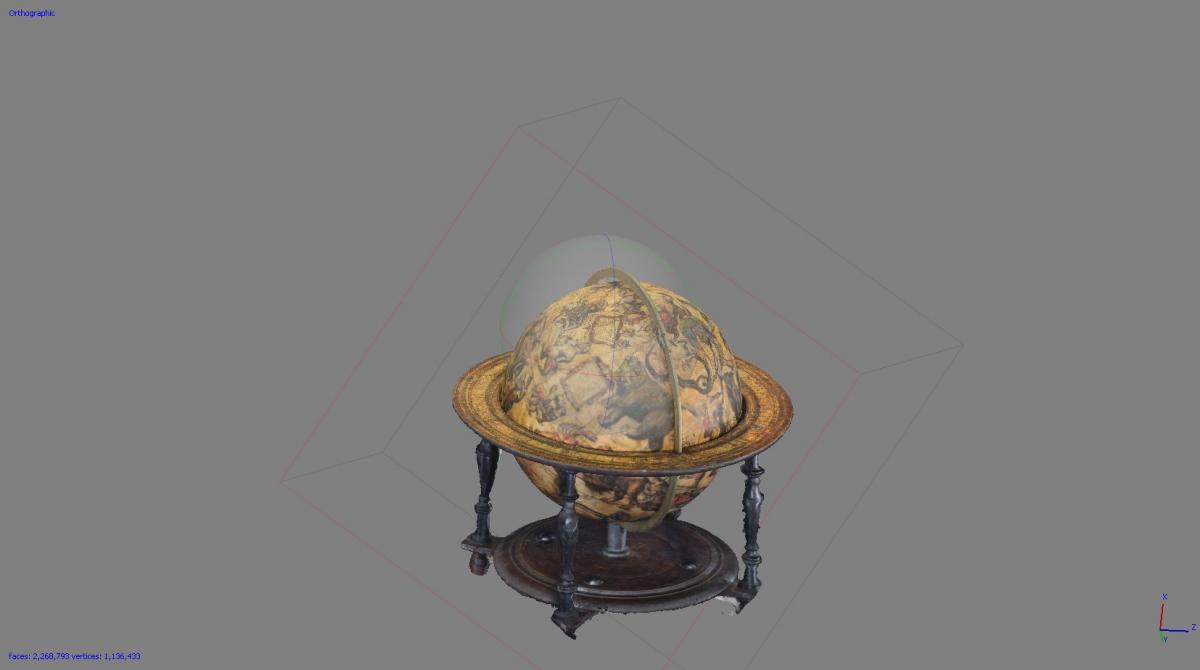
Following on from February’s edition of eNews, Kate Pentecost (ANMM Digital Curator) has built a 3D model of the Museum’s 1602 Blaeu celestial globe using a process known as photogrammetry (culturalheritageimaging.org/Technologies/Photogrammetry/). Kate’s model has allowed us to document this complicated 3D object. The model can be rotated and a zoom function can be used to reveal its general features and condition.
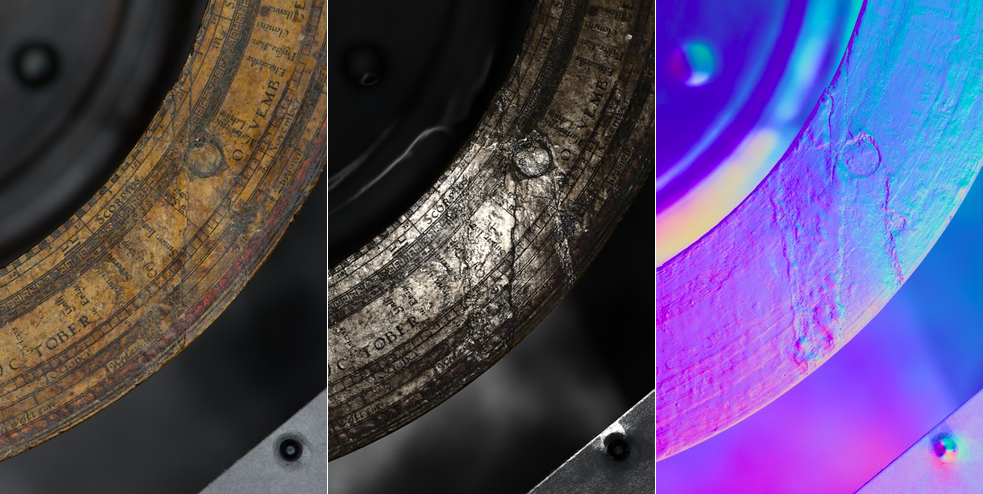
Katie Wood and Nick Flood used the RTI (Reflectance Transformation Imaging) technique to get a better understanding of the fabrication, restoration and condition of the Blaeu globe. RTI is a fairly simple and inexpsensive technique that combines numerous (~48) photographs to create a computer model that is able to reveal fine surface details (culturalheritageimaging.org/Technologies/RTI/). RTI is great for identifying and documenting previous repairs and hidden inscriptions. Our results show differences in textures due to the intaglio printing process and several areas of damage and repair.
Exhibition preparation
Sue Frost, Jeff Fox, Katie Wood and the rest of the conservation team have been working hard to take down the James Cameron – Challenging the Deep exhibition after almost 12 months on display.

Workshops, symposia and media
With the support of the Gordon Darling Foundation, Lucilla Ronai represented the museum at the American Institute for Conservation (AIC) Annual Meeting of conservators in New England. Luci exhibited a poster that showcased her work managing the cellulose acetate and cellulose nitrate (CAN) transparent film in the National Maritime Collection. After attending the conference Luci visited numerous American institutions with expertise in CAN material.
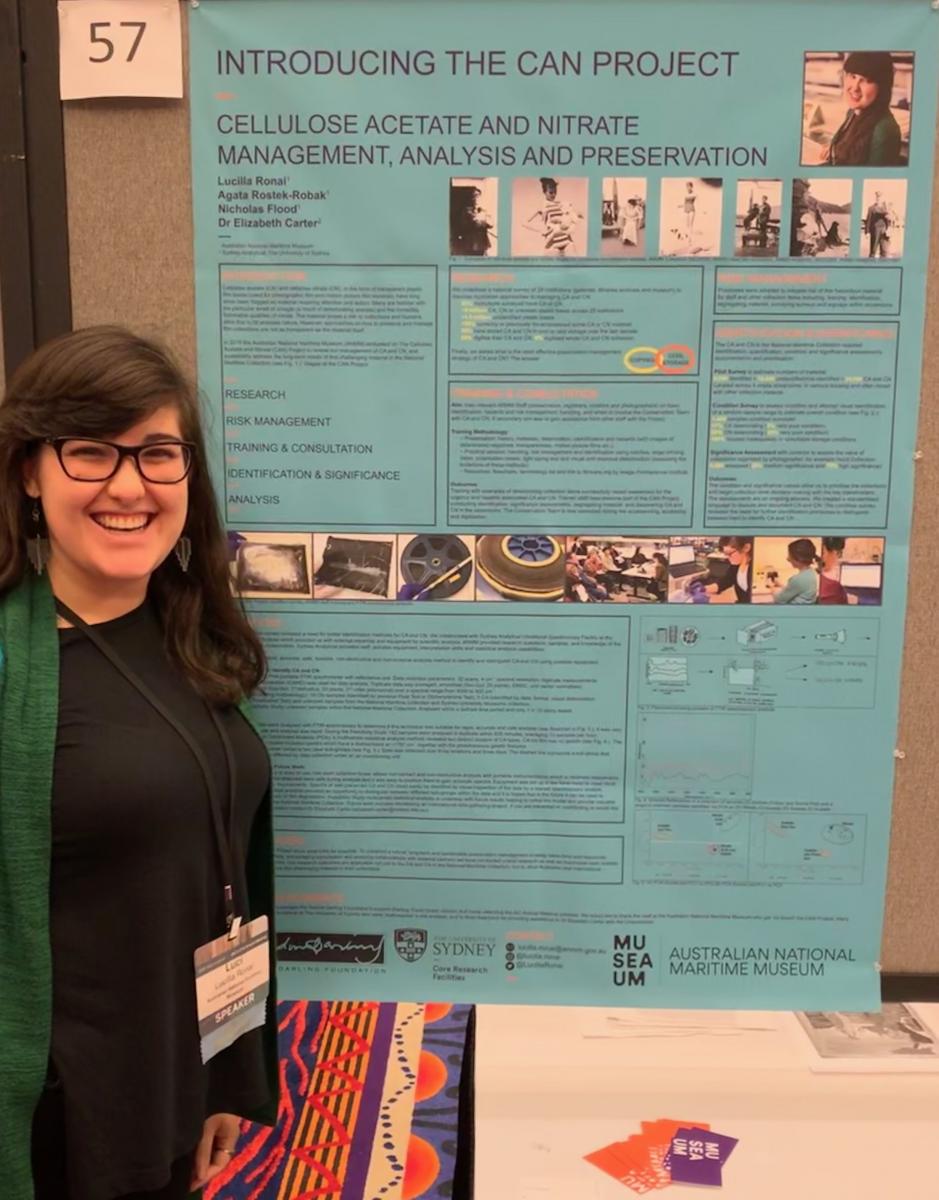
Social
In May, the Museum held its 22nd annual staff regatta. Staff were divided into teams to crew yachts in a race around Sydney Harbour. Katie Wood and Nick Flood flew the flag for conservation on the day.

Nick Flood had an XL (read 40th) birthday recently. The conservation team celebrated by heading out on the replica HMB Endeavour for an afternoon as the vessel went through its sea trials.

Australian Museum
Social
Colin Macgregor is retiring from his position, Manager, Materials Conservation Unit, after 30 years of service. It is a time of significant change for the Unit without Colin at the helm, and with that brings new challenges and opportunities. We all thank Colin for his support, guidance, and continuous promotion of the importance of the work we do in collection care throughout the Museum. We will miss that broad Scottish accent, gentle nature and witty demeanour. All the very best Colin in your upcoming adventures!
Brooke Randall left the department in April to begin work at the Museum of Applied Arts and Sciences as Deputy Team Leader for their relocation projects. Brooke’s drive and energy will be sorely missed. We wish her all the best at MAAS!
Rehan Scharenguivel has left the department to take up a permanent role at International Conservation Services. We wish Rehan all the best in the new role, and will miss his consistent contribution to the lab!
Professional
After an internal application process, Sheldon Teare and Heather Bleechmore were successful in applying to act as Manager of the Materials Conservation Unit while Colin is on extended leave. Sheldon will act as Manager for the next nine months, until February 2020, when Heather will take up the reins for another nine months until November 2020.
Exhibitions
Sheldon Teare and Megan Dean-Jones have successfully de-installed the Whales Tohora exhibition for its safe return to New Zealand’s Te Papa. Heather Bleechmore is working through Archaeological collection material selected for a new permanent display entitled Mahn in Bayala Nura Gallery. The display will consist of over 200 stone points, stone axe heads, and fishing hooks as well as four newly acquired woven canoes from the South Coast of NSW.
Loans
Michael Kelly is preparing a number of objects from the First Nations collection for a loan to the Art Gallery of South Australia.
Treatments/Projects
Megan Dean-Jones and Sheldon Teare have been very busy carrying out the delicate work required on the Chapman Gallery Relocation Project. Megan has taken on the bulk of this work as Sheldon has had commitments as Acting Manager of the Unit. Much of this significant mineral collection will go on display at the Australian Fossil and Mineral Museum in Bathurst for a few years during the AM’s extensive building works. All the Chapman specimens are now safely packed in high-quality storage systems and those selected to travel to Bathurst are ready for their relocation. Megan and Sheldon will head up to Bathurst with a team of Mineralogy collection and exhibition staff members in early June to install the new Chapman exhibition.
Heather Bleechmore continues to coordinate the Pacific Collection Relocation Project, with the first stage almost complete. Due to finish on 31 May, the project has seen a team of conservators and art handlers safely relocate almost 50,000 objects to the new Cultural Centre at Rydalmere. Elizabeth Reed, Fiona Hurel, Jessica Gray, and Kyra Kim are working through the last few packing challenges, whilst also assessing the unpacked items at the new store and assisting the Collection Management team with storage issues. Final stages of the project will run over into the second half of the year as priority rehousing projects are addressed.
Conferences
Sheldon, Rehan and Colin travelled to Melbourne in February to attend the Managing Risks Conference.
International Conservation Services
White Rabbit Gallery – NGV Exhibition
No doubt you’ve heard about the new exhibition at NGV, A Fairy Tale in Red Times: Works from the White Rabbit Collection.

In March and April 2019, Matteo Volonté, Eden Christian, Julia Van Den Burg and Adam Godijn from the Paintings Team spent almost two weeks at White Rabbit undertaking detailed pre-transit condition assessments and conservation treatments. The artworks chosen to feature in this exhibition needed to be stable enough to travel and also spend many months at the NGV on display.

National Trust Award for ICS
We are pleased to announce ICS received the top award in the 2019 National Trust of Australia Awards (NSW) in the category of Conservation of Interiors and Objects. This was for conservation of the superb wrap-around plaster mural designed and built in the 1930s by Melocco Brothers at the Food Court at Central Station, Sydney. The mural was covered in grease from fast food outlets and soot from an adjacent fire. Arek Werstak, Katie Wood and Rob Williams from ICS worked with a team of graduate conservators over two months to carefully clean and restore the mural to its former glory. Extensive media coverage highlighted this extraordinary artwork and the conservation work. A number of interpretive devices have been developed to showcase the mural, including an interactive online panorama.

Paper Team
The Paper Team has been run off its collective feet attending to various mould-related issues. Mould seems to be really ‘in’ at the moment and it’s not letting up any time soon! In-between the mould work, Wendi Powell and Jen Todd have kept busy with small artworks for private clients and a number of collection assessments.
Textiles Team
Christina Ritschel, Senior Textiles Conservator, has been working at the Sydney Opera House preparing for and installing the two magnificent tapestries designed by John Coburn for the Opera Theatre (Curtain of the Sun) and the Drama Theatre (Curtain of the Moon). Although impractical for permanent display, the opportunity to hang the curtains in their original locations (albeit for only a couple of days) has generated a great deal of excitement and public interest.
Outdoor Heritage and Furniture Teams
The conservation of the Port Fairy cannons and carriages continues, with expert guidance and conservation efforts from Karina Acton, Wendy Reade and Oliver Hull. A range of monuments and memorials have also been conserved recently, including the work by James Kleppen and Rob Williams on Folly for Mrs Macquarie in the Sydney Royal Botanic Gardens, and Juxtaposition in the Brisbane CBD. James and Karina have also been working solidly to develop a long-term maintenance plan for the monuments and memorials of Liverpool City Council.
Collections Management Team
The Bundanon Trust is building a new facility on the South Coast of New South Wales, and Fiona Tennant and Julian Bickersteth were invited to provide guidance on collection storage needs. The Trust announced in April that it had received a grant of $22 million from the Australian Government, representing the final contribution towards a total of $30.6 million required to embark on the dynamic design project for the Trust’s Riversdale site. Fiona also travelled to WA to assess housekeeping needs for the National Trust of WA and develop workshops and protocols to support the preservation of a number of historic house collections.
Staff News
We are delighted to welcome a new staff member to ICS: Kristine Allinson, Objects Conservator, joins our Melbourne lab. Kristine previously worked as a casual with ICS in 2018, and prior to that worked with Heritage Victoria, the National Gallery of Victoria, and various archaeological sites with Monash University. Still in Melbourne, in March we farewelled Lauren Keating, who has decided to pursue a career outside the world of conservation: we wish Lauren all the very best. Rehan Scharenguivel, Objects Conservator, joined our Objects & Outdoor Heritage Team in Sydney in April, after previously working with the Australian Museum and the Museum of Contemporary Art. And Claire Heasman has returned to the Paintings Team after 12 months parental leave: welcome back Claire!
Tony Ng has joined ICS in a senior role as Commercial Manager, a new position that reflects the importance we place on supporting conservators to deliver excellent conservation outcomes for our clients. Tony has a background in accounting and financial analysis from the IT and advertising sectors. Ruth Thompson continues as Operations Manager, with responsibility for managing our staff and their delivery of conservation work across the full breadth of ICS projects.
David West is stepping back from employment within the business, and transitioning to a non-executive role with a continuing share of business ownership. David is taking on a new role as a Technical Director with Inhabit Group, where he will pursue his interests in forensic engineering and façade consulting.
Julian Bickersteth has stepped into the role of Chief Executive Officer, with overall responsibility for business outcomes and business development.
Museum of Applied Arts and Sciences (MAAS)
The Powerhouse Museum’s move to Parramatta continues to hit milestones. The Minster for the Arts, Hon. Don Harwin, announced the six finalist design teams shortlisted for the Powerhouse Precinct, Parramatta. The first stage of the competition attracted 74 submissions from 20 countries, made up of 529 individual firms from five continents. The evaluation process resulted in the six highest-scoring submissions being selected to compete in stage two of the International Design Competition.
The Collection Relocation Project commenced in mid-April and saw 17 newly appointed conservators and registrars begin several weeks of training prior to the start of the first three-year phase. This first phase of the project will involve the assessment of some 300,000 objects held at Ultimo in preparation for digitisation and packing for the relocation. Rebecca Ellis, Conservation Team Leader would like to welcome Brooke Randell as Deputy Team Leader and Assistant Conservators Megan Hall, Bronwyn Dunn, Bindiya Kumar, Karina Lavings, Felise Reakes and Judy Kim, who have joined the assessment team and will be working in partnership with our Registration colleagues. Elizabeth Reed and Jessica Grey will join the team in June.
Farewell to Belinda Christie (conservation photographer) and welcome back to Emma Bjorndahl (conservation photographer).
Suzanne Chee is working on the Jenny Kee and Linda Jackson: Step into Paradise exhibition. Over 150 garments, textiles, photographs and artworks, many previously unseen, from the Museum’s own extensive collection will be brought together with pieces from the designers’ personal archives. Highlight pieces on display will include artwork from the pair and archival behind-the-scenes photographs, Jenny Kee’s black opal Chanel suit from Karl Lagerfeld’s first collection in 1983 and Linda Jackson’s iconic dress Waratah.
Gosia Dudek is preparing the objects for Linear, an exhibition that explores the concept and significance of line and lineage with the cultural narratives and practices of Australia’s First Nations Peoples across science, technology, design and aesthetics.
Tim Morris and his team of volunteers are preparing objects for the Apollo 11 exhibition. With over 200 objects, Apollo 11 commemorates the 50th anniversary of the moon landing. Key objects on display include items from the Museum’s extensive collection and from around the world: a feed horn used on the iconic CSIRO Parkes radio telescope, responsible for receiving some of the first images of the moonwalk for broadcast around the world; parts of the Redstone Rocket that put the first American into space; and an Olivetti Programma 101 computer, the type used by NASA to calculate the launch and landing.
Teresa Werstak is reorganising our exhibition cleaning schedule.
We have received our new Olympus VANTA XRF analyser to be used for elementary analyses, quantifications and alloy identifications.
Sue Gatenby is working on a set of hazardous materials fact sheets.
A training course on radiation and radioactive materials is underway by Gammasonics.
State Library of New South Wales
Social
In the Digital Excellence Program team, Bronwen Glover has temporarily left the team and accepted a 12-month paper conservation internship at the Canadian Conservation Institute (CCI). The CCI works within the Department of Canadian Heritage to promote the proper care and preservation of Canadian moveable cultural heritage and to advance the practice, science and technology of conservation. As an intern, Bronwen will be able to actively contribute to both the development and implementation of conservation standards, thereby gaining in-depth knowledge of collection needs.
Felicity Corkill, Senior Conservator of Books, Objects and Paintings, and Lauren Dalla, our Assistant Registrar, will soon be taking maternity leave.
Professional
The Collection Care Branch has been working in sub-standard accommodation for the past few years, compounded by recent gallery development which reduced the space for the Branch even further. After several options for a new space were unsuccessful, the State Librarian has recently succeeded in securing funding for facilities, giving new impetus to identifying an appropriate location. Much discussion and deliberation has taken place to find a space in buildings with significant heritage considerations and a distinct lack of obviously available space.
In April this year, the Library’s Executive agreed on the location for a new lab, which is adjacent to the existing Macquarie Lab. This means we can now commence the exciting but immense task of consulting with a branch of 25 staff and working with architects, engineers, designers and heritage experts to realise the new facilities. It also means we can build the new facilities while we continue with our day-to-day work. When building is complete the Macquarie Lab will be re-purposed for other Library functions.
The new lab will increase the total space available for the Branch by approximately 200m2 and enable us to design and build a flexible, open-plan space equipped with up-to-date equipment and services. Two other existing Collection Care spaces, the Domain Lab and Shakespeare Lab will be refurbished for continued use by the Branch.
The development of new Conservation / Collection Care facilities is a rare thing, so we will keep everyone updated with our progress over the next year or so.
Treatment projects
The Collection Care Digital excellence team recently completed treatment of the Dixson numismatic paper currency, which forms part of the Dixson numismatic collection. This collection includes coins, tokens and medals and has been steadily undergoing conservation treatment and digitisation since 2013. The metal items have now all been treated, rehoused and digitised, leaving only the paper currency. In the past, each of the paper notes had been adhered to plastic with a strip of double-sided tape attached to the back. These were then encapsulated between sheets of plastic, which were also sealed with double-sided tape, keeping the notes secure and in the correct order. A survey of the collection completed in 2013 found that all notes (849 items) displayed some form of acidic staining and adhesive migration into the paper substrate. To prevent further damage, we proposed to remove the notes from the encapsulation and also remove the double-sided tape. The notes could then be rehoused and digitised to complete the digitisation of this collection.
Testing in 2013 using heat and solvent removal techniques identified a two-step treatment procedure that successfully removed, firstly, the encapsulating plastic adhered to the note using a solvent, and, secondly, the adhesive residue by mechanical means (crepe eraser). Treatment of the collection began in 2015 and almost one third of the collection was successfully treated and rehoused. However, some issues became apparent during this time as the notes were not labelled, meaning conservators treated one note at a time to retain the labels with the items, adding significantly to the treatment time. Also, the paper quality of the notes varied greatly – some were extremely pulpy and degraded so use of a crepe eraser was not possible as it led to further damage.
The treatment and the collection were revisited in 2018 as a Digital Excellence Project. We began looking at the treatment procedure and questioning whether we could use other solvents or methods to remove the adhesive and tape. Could we work on more than one note at a time whilst still retaining the item’s call number? We came up with the following simple variations and improvements:
- Using a magnetic whiteboard with magnetic pins to keep the notes and their labels together during treatment.
- Testing other solvents to remove the adhesive without solubilising the inks.
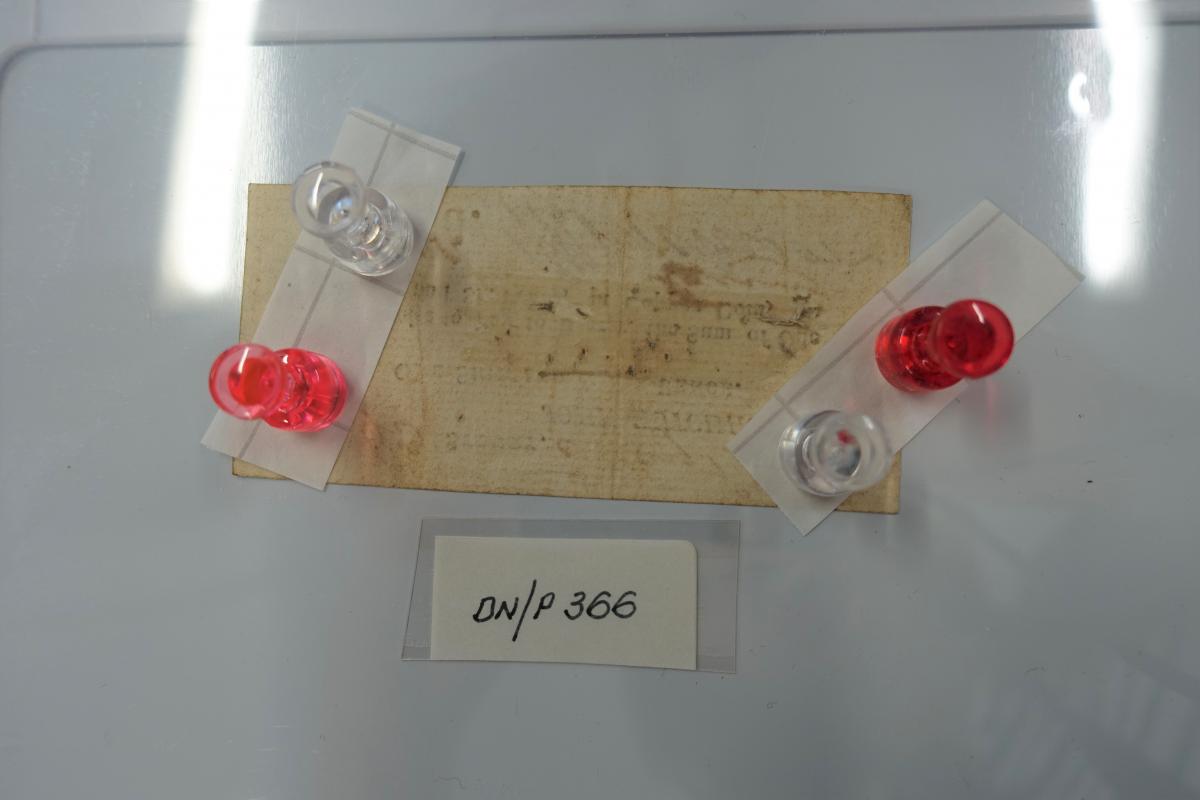
- Using cellulose powder poultices to safely remove the adhesive without abrading the soft paper fibres on the notes.
We also tested the use of gels and gums as a vehicle for the solvent; however, we found that dry cellulose powder worked best for the paper currency. These simple treatment adaptations greatly reduced our treatment times and caused less damage to the fragile notes.
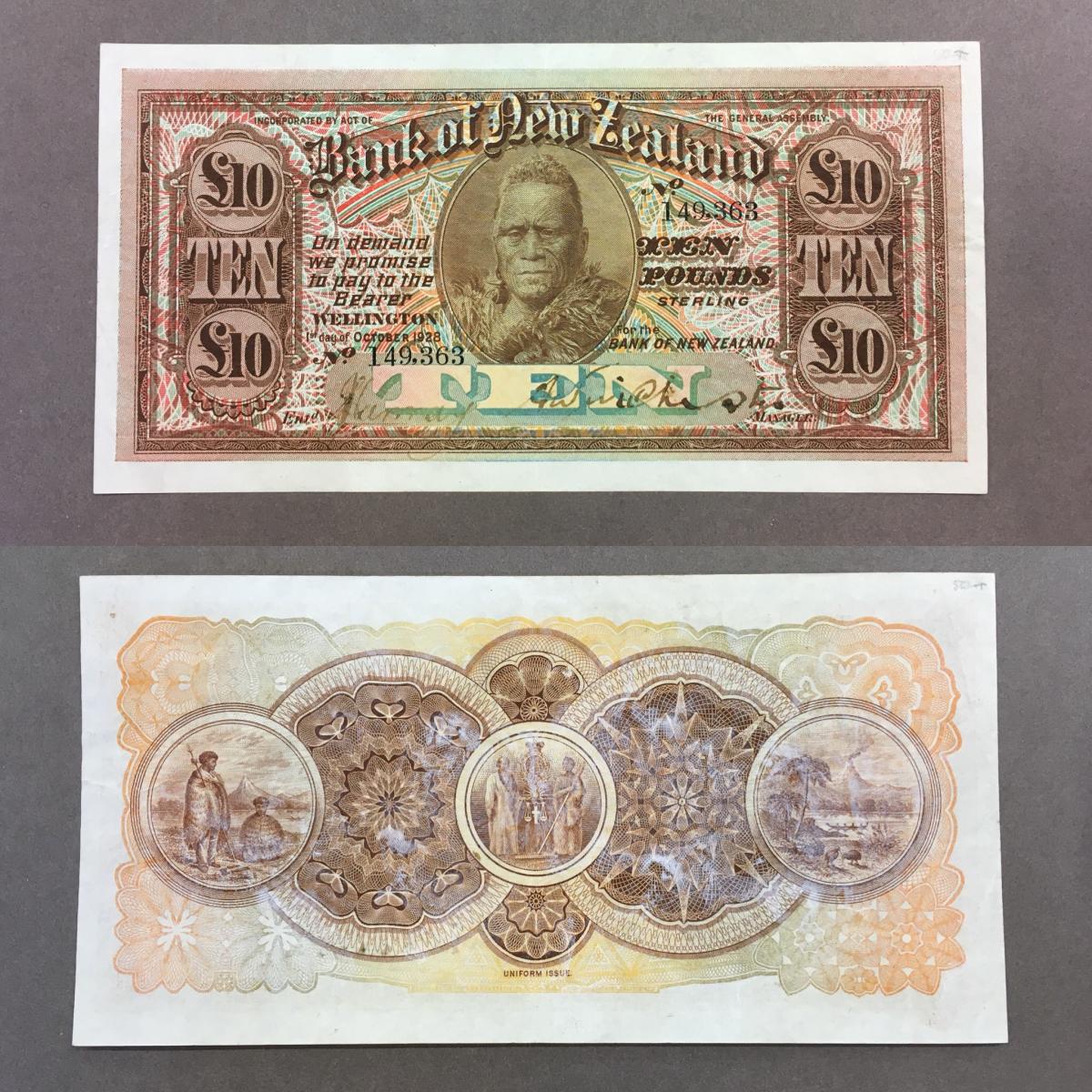
The notes are now rehoused in archival enclosures and boxes, ready for digitisation.
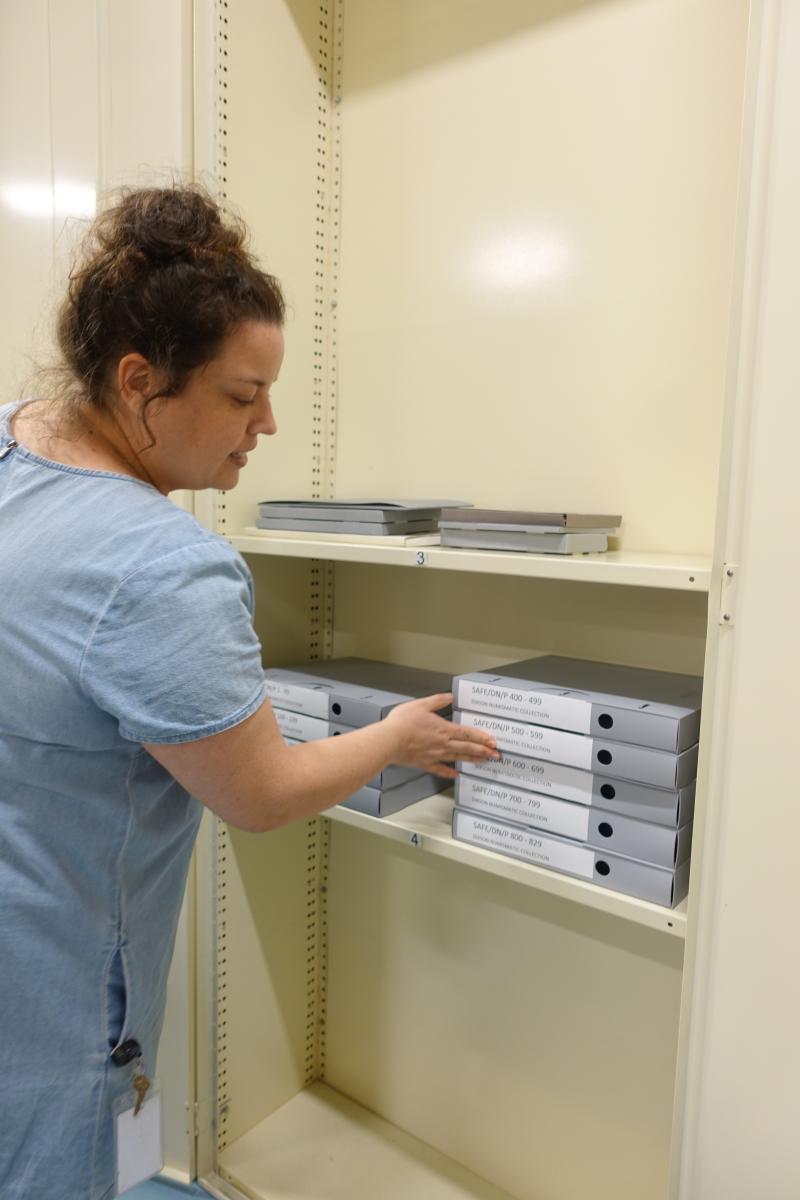
Exhibitions
Our Exhibitions and Loans team have been busy preparing for Dead Central, an exhibition about Devonshire Street Cemetery, where Sydney’s Central Station currently stands, in the 19th century. This exhibition opens on 25 May.
Conference attendance
Helen Casey, Felicity Corkill and Dana Kahabka presented at AICCM’s FRAME: Concept, History and Conservation, Symposium 2, on 3–5 April at the Art Gallery of New South Wales. Helen presented a paper on the unique frames of Mary Edwell-Burke, Felicity gave a paper on the strategies undertaken to prepare the permanent display of the Library’s framed painting collection in the recently refurbished exhibition galleries in the Mitchell building, and Dana presented a lightning talk on the Library’s miniature portrait frames.
In the Collection Care Digital Excellence Program team, Natalie Cassaniti and Annie Breslin will be heading to Indiana University, USA, to attend the Biennial Audio-Visual Archival Summer School (BAVASS) 2019. This two-week (13–26 May) comprehensive summer school will cover a complete range of the issues and topics required to work in the field of audio-visual preservation. Natalie and Annie are two of 50 participants accepted into this course, which will be presented by international experts within the AV field. Natalie and Annie will also be participating in some site visits to cultural institutions to view preservation and storage methods for audio-visual collections.
South Australia
Artlab Australia
Professional
Conference attendance
Megan Sypek attended the AICCM FRAME: Concept, History and Conservation, Symposium 2, in Sydney in April. The depth of experience and energy amongst the delegates was both inspiring and invigorating. Back home at Artlab she is setting up a large treatment project of historical waterlogged wood specimens.
Treatment projects
Jo Dawe has spent the past few months treating a privately owned, English parcel-gilt silver epergne, dating from circa 1873.
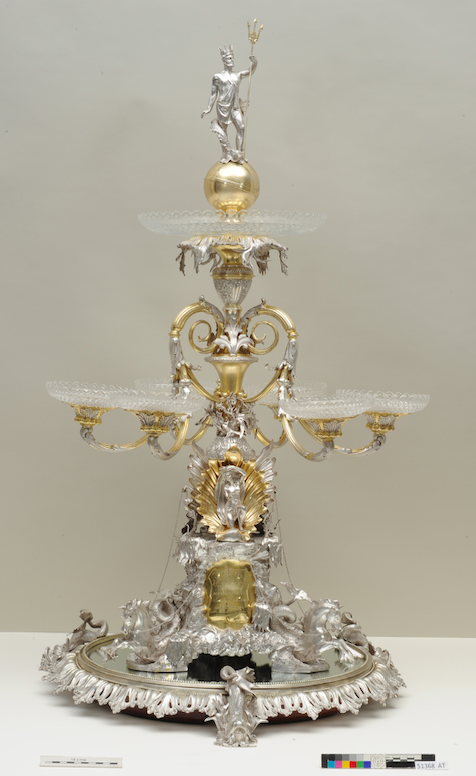
The epergne is visually spectacular, standing at over a metre tall, with 39 separately attached components (and their specific-thread nuts). Over many years, layers of tarnish had built up on both the silver and gold-plated surfaces, affecting the overall aesthetic appearance of the epergne.
Due to the scale of the piece and its many removable pieces, thorough documentation and labelling was paramount before, during and after treatment. Filipa Quintela assisted Jo with the (quite arduous!) silver polishing stage. After polishing was complete, all separate components of the epergne were coated with two layers of Paraloid B-72 to slow the rate of tarnish reformation. A detailed treatment report documenting the epergne’s dismantling and reassembly was provided to the owner for their reference and to assist with any possible future treatments (which we hope will be well into the epergne’s future!).
Kristin Phillips is currently spending three weeks in Hobart working at Tasmanian Museum & Art Gallery, undertaking treatment of the Lloyd quilt. This quilt, made in 1810–25, requires stabilisation of degraded areas and is being funded by a Copland Grant.
Ian Miles has completed the removal and reinstallation of two outdoor monuments; a large 5.6-metre-tall, stone war memorial and a small, two-stepped stone water fountain at Blackwood, SA. Road improvement work at a busy Blackwood roundabout required the removal and relocation of the two monuments. The work had a critical end date of ANZAC Day (25th April) so Ian was working to a specific deadline (often nail-biting with outside project work). Both were completed before schedule and, scarily, all went to plan! The opening and unveiling were presented by RSL member Bob Killoran, current state government MPs and associated dignitaries.
The Paper lab has a new volunteer, Jorji Gardener, who is assisting with work on the stabilisation of 19th– and 20th-century paper labels from the ornithology department of the South Australian Museum.
Roberto Padoan is investigating a mysterious set of drawings of saints for dating and provenance.

These drawings were discovered in an historic house in Adelaide where they were being used as lining for a cabinet drawer. Preliminary investigations, using palaeographic and material analysis, indicate that they are Italian and from the second half of the 17th century. Further investigations are now being conducted to try to identify the artist/s.
Liz Mayfield is investigating a new biological test and UV radiation sterilisation setup for use in the treatment of moulds on paper. Liz will be testing the germicidal efficiency of both UVB and UVC radiation at different light doses.
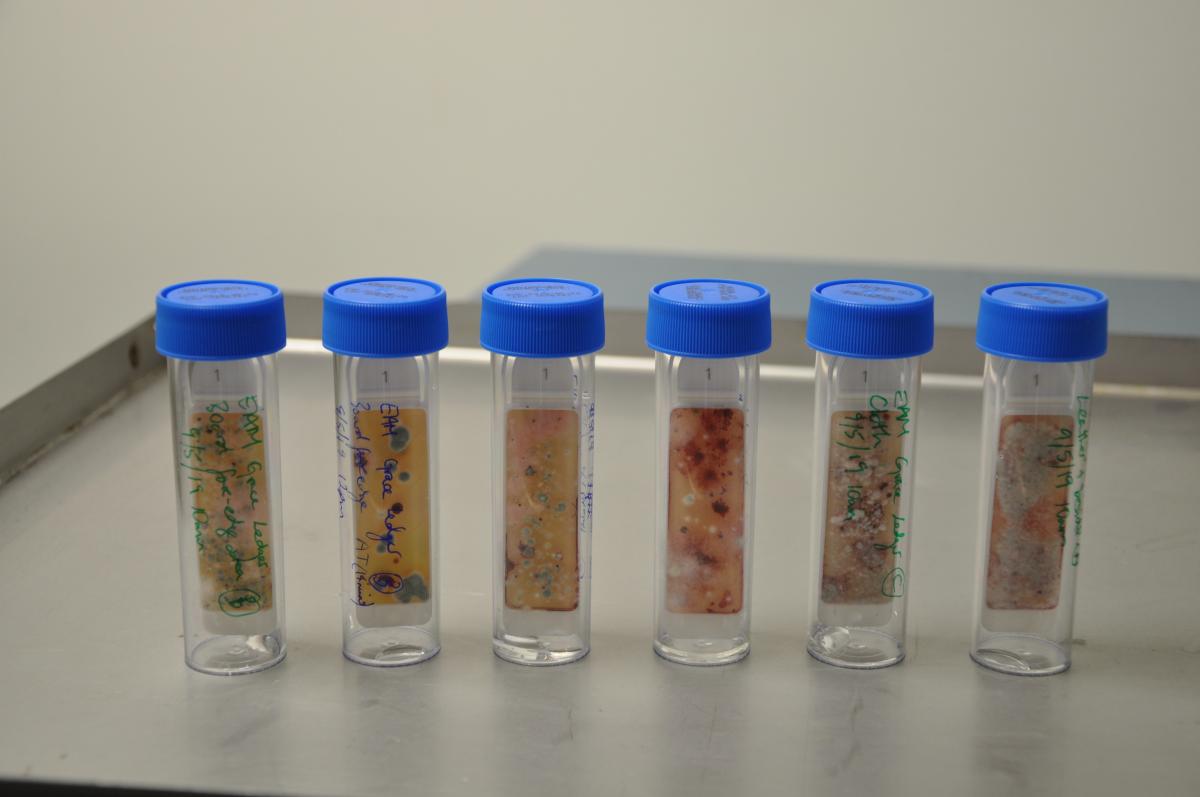
Exhibitions
Artlab is involved each year in South Australia’s History Festival, which runs for the month of May and includes almost 700 events presented by over 400 individual event organisations. As such we host a busy week of guided Artlab tours, where we invite members of the public to view ‘A Day in the Life of a Conservator at Artlab Australia’. This week we will have hosted close to 150 members of the public through our various labs. These tours are very popular, often booking out well in advance, and are a terrific opportunity for us to share what we do and why and increase the public’s knowledge of the conservation profession and the vital work we undertake.
Justin Gare’s search for meaning and fulfilment, brought on by his post mid-life crisis, has led him to spend 140 hours making a 1/10 scale wooden architectural model of Sir George Strickland Kingston’s monument to Colonel William Light (first Surveyor-General of the colony of South Australia and responsible for fixing the site for Adelaide) which was built in 1843.

The 45ft gothic edifice towered over the fledgling colony for 60 years before it was demolished, and long since forgotten. Justin hopes it will be rebuilt for the 2036 South Australian bicentenary, only this time he would like it to be inclusively dedicated to the traditional custodians of the Adelaide plane, the Kaurna people; the vision of the ‘Old Colonists’ of the South Australian Association, and the pioneering settlers. He has curated an exhibition of photos, wood engravings, paintings and artefacts pertaining to the monument, which is on display in the foyer of Artlab Australia for the History Festival – and has made the state news, on various platforms, in the process! (see: https://historyfestival.sa.gov.au/34074 and https://m.facebook.com/story.php?story_fbid=1991700250957936&id=963049747156330 for more details.)
Victoria
The Grimwade Centre for Cultural Materials Conservation — Commercial Conservation Services
The Objects Team has been particularly mobile this month on a number of projects around Victoria and interstate.
Evan Tindal and Jordi Cassasayas were fortunate enough to spend a number of days in Williamstown soaking up the lovely autumn sunshine and seaside air. They also managed to find time to complete conservation work on another of the Bills’ horse troughs, a heritage concrete drinking trough gifted to the City of Williamstown in the late 1920s by George and Annis Bills. The trough is the second worked on by the Grimwade, with the one prior treated at the North Melbourne facility in 2017 and reinstalled on the Williamstown waterfront mid-2018.

Further afield, Evan Tindal and Victoria Thomas travelled to Brisbane to assess the condition of over 150 works in the City Council’s public art collection. The collection ranges from traditional bronzes and carved stone memorials to more modern neon signs and aluminum coated in automotive paint. The coincidence of the project with the Easter holiday week meant even the public works were in holiday mode, presenting the question to these two conservators: where is the check box for yarn-bombing?
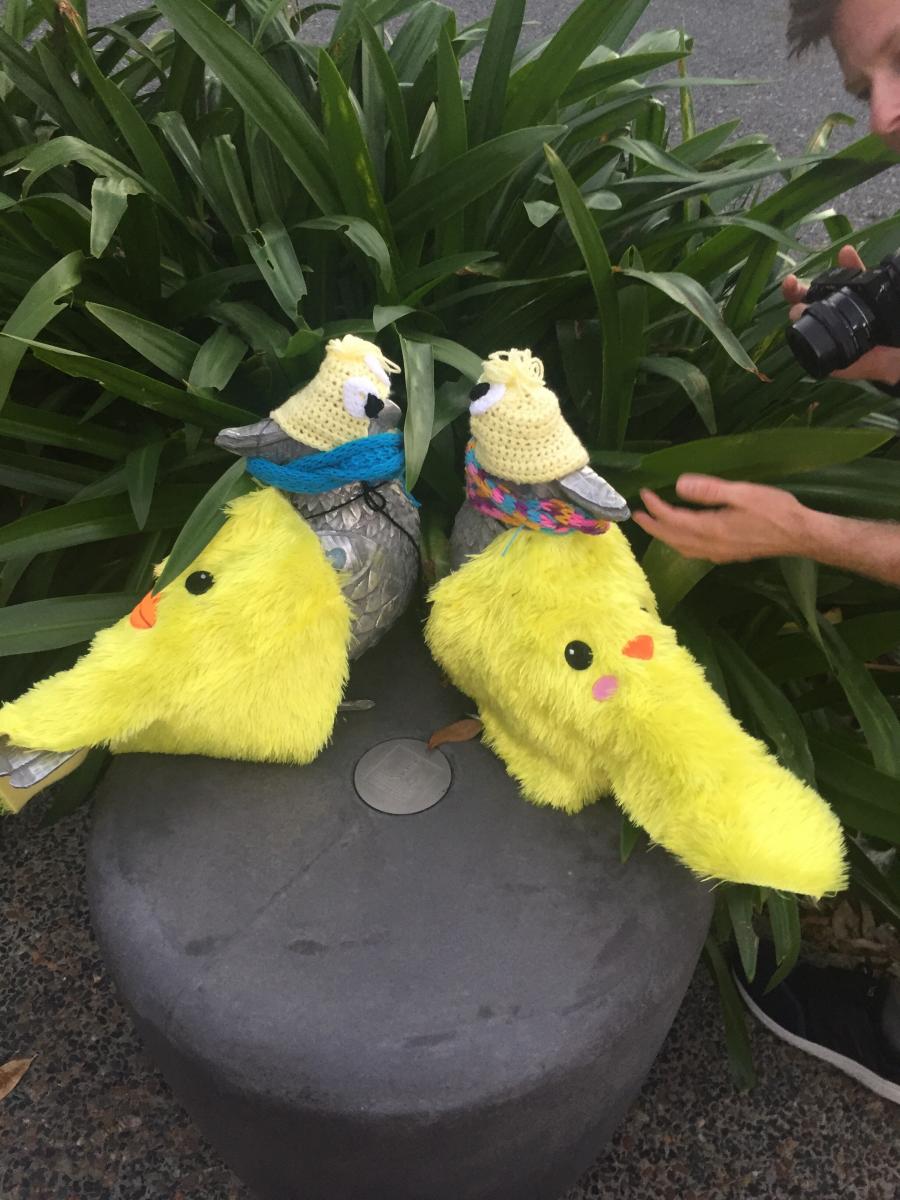
In April, Jacinta Brown travelled to Ararat for five days to assist the team at Ararat Gallery, Textile Art Museum Australia (TAMA), in the early stages of a project to digitise their 1200-piece collection. The project is a partnership between Creative Victoria, the NGV and the Public Galleries Association of Victoria aiming to increase awareness of regional Victorian collections through digital access. Ararat Gallery TAMA was selected to take part in the pilot phase of the project, which will travel, roadshow-style, to other regional cities in the state (Benalla and Morwell). Working with the team there was a great opportunity to get a look at one of the most significant regional collections in the state, and to provide conservation mentorship and share the necessary knowledge for the local staff and long-term volunteers to carry out this important project.
After finishing up on-site conservation work during excavations of multiple sites in the Melbourne metropolitan area last year, the Archaeology Team of Holly Jones-Amin, Marica Mucic, Emma Hayles and Evan Tindal have been hard at work on the post-excavation treatment and assemblage of hundreds of items. The objects range from small items like nails and buttons, to large textiles and ceramics. A selection of the excavated items from the Metro Tunnel site have been put on rotating display at Metro Tunnel HQ and at the Young and Jackson Hotel.
In the Paintings Lab, Vanessa undertook preliminary conservation treatment of a Mirka Mora painting in preparation for the current Mirka for Melbourne exhibition at Heide Museum of Modern Art. While the painting was in good condition overall, there were some minor areas of damage that needed stabilising, involving adhering areas of cracking and flaking paint to prevent loss, as well as some larger areas of paint loss that were distracting and needed retouching. After the exhibition, a full conservation treatment will be undertaken, which will include overall cleaning and further retouching of minor paint losses and scratches.
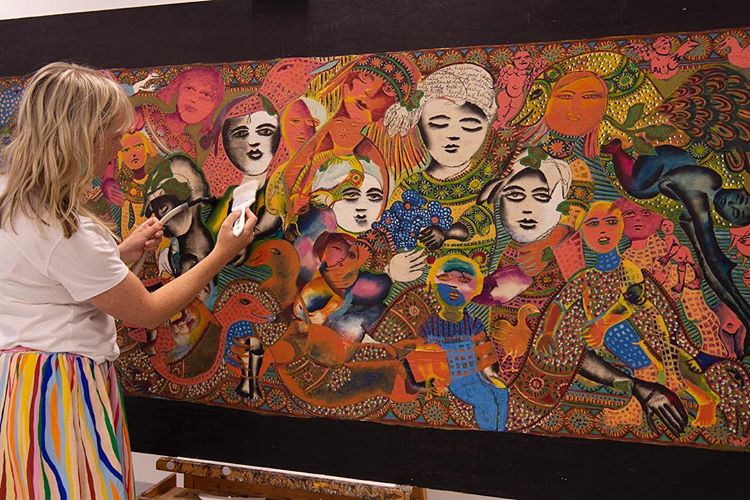
The Paper Lab was flat out through the start of the year dealing with results of a series of floods in December and January. Since we put that behind us, Book and Paper Conservator Peter Mitchelson completed a major treatment of a badly damaged 19th-century wall map, which required washing and relining followed by extensive filling before mounting.
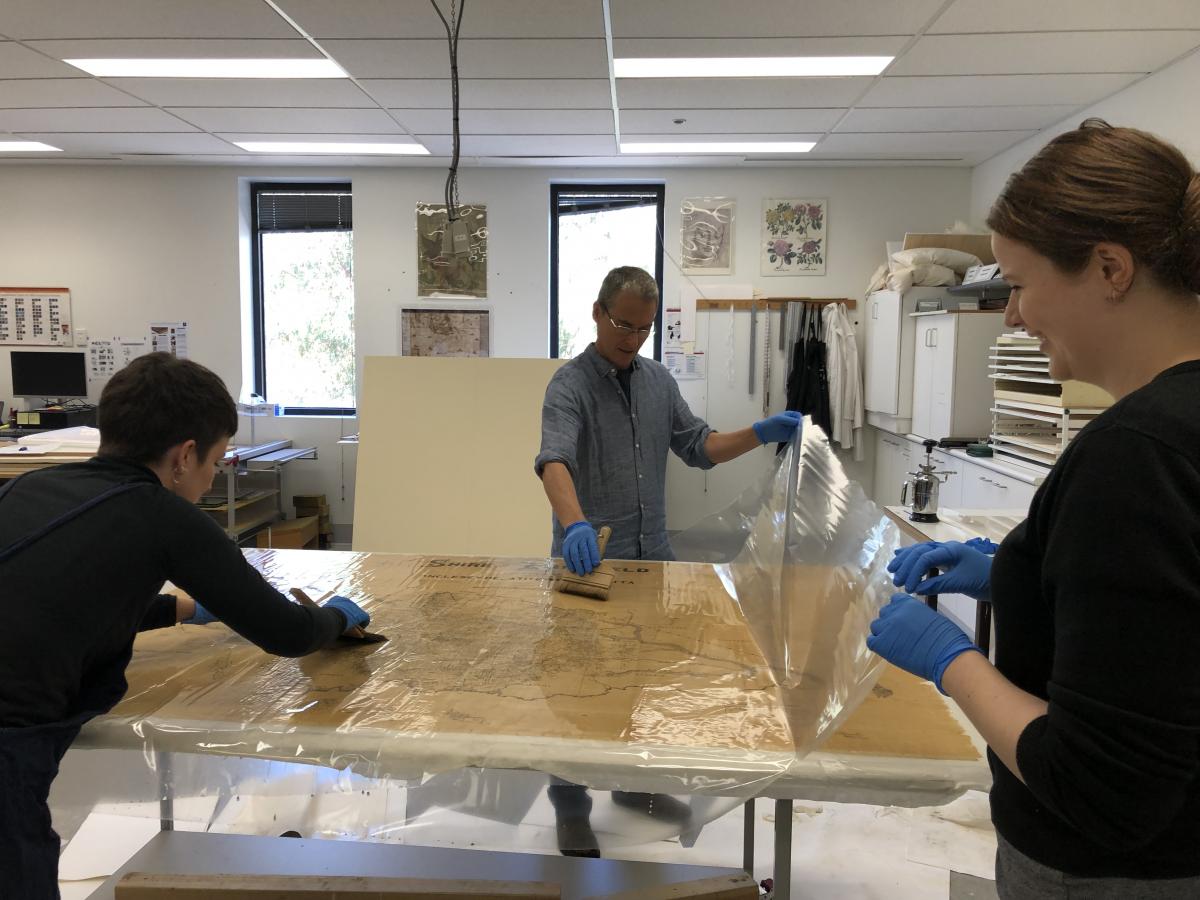
Paper and Photographic Conservator Noni Zachri worked with Museum Victoria staff to analyse the massive Women’s Suffrage Petition from the collection of the Public Record Office Victoria to inform its future display conditions.

Finally, we welcomed a new graduate intern – Christine Mizzi. Christine will be with us for 12 months working a range of conservation and research projects, and assisting with the day-to-day running of the lab.
National Gallery of Victoria
Social
In April, the Conservation department welcomed Jessica Lehmann to the role of Conservation Project Officer. One of Jess’s first activities has been to assist MaryJo Lelyveld with updating contact lists and refreshing disaster bin consumables as part of the Collections Disaster Preparedness and Response program to coincide with Blue Shield Australia’s May Day and in preparation for winter rains.
Michael Varcoe-Cocks has been clocking up the kilometres travelling to regional Victorian galleries as part of the Creative Victoria Digital Roadshow: Collection Digitisation.This project saw Michael, Skye Firth and Ellen Doyle travelling to Ararat Gallery, Textile Art Museum Australia (TAMA), to undertake conservation outreach and educational activities for gallery staff, members and students. Michael is also working through a long treatment of Hugh Ramsay’s Consolation.
The Conservation department has also benefitted from Deborah Lau from CSIRO running FTIR workshops with attendance from across the labs. An intriguing discovery included a textiles collection piece with gelatine in the place of where diamantes would typically be.
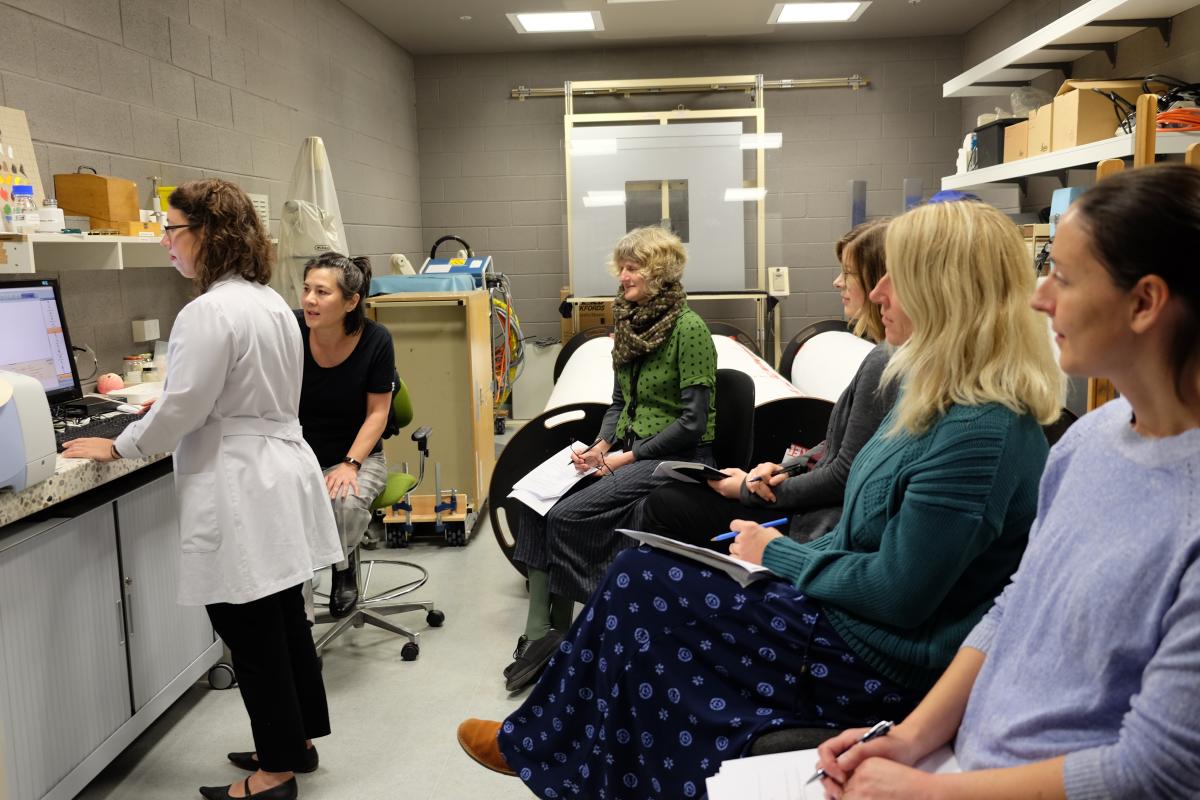
Textiles
Kate Douglas, Kate McLaren and Skye Firth of the Textiles conservation team presented two papers at the February AICCM Textiles Conference in Sydney. Di Knight has also returned to the Textiles Lab to assist with a busy exhibition program. The team is currently working on a series of loans for the coming year including batiks for an upcoming loan show in Bendigo in August and preparing new acquisitions works for display, most notably a contemporary Chinese work by designer Fang Ye of a dragon robe covered in thousands of gold hairpins and Iris van Herpen’s Frozen Falls.
Paintings
Since February, the NGV Paintings conservation studio has been delighted to host Deborah Lau on a four-month secondment from CSIRO for the conclusion of an important collaborative project. Over the past three years the NGV, CSIRO and the specialist chemical manufacturer Boron Molecular have developed a successor to the much-loved MS2A varnish resin, which went out of production in 2014. This new varnish, named MS3, represents a third generation of this form of resin, which was first produced in the UK in 1959. A team of scientists from CSIRO, led by Deborah and Chief Research Consultant John Tsanaktsidis, were able to develop a new chemical production process aimed at producing a varnish with the same handling and aesthetic qualities as the earlier version, but with improved colour and consistency, and greater resistance to cross-linking. Deborah and Carl Villis tested numerous prototypes and are currently preparing a report for publication. Further details will follow in the next issue of the newsletter.
During her secondment at the NGV, Deb has also collaborated with Raye Collins on another major project to apply FTIR spectroscopy as a work and research tool for conservators at the Gallery. This has involved creating an in-house library of spectra, testing a variety of materials, upgrading software and conducting workshops for conservators across various labs.
In other news, the paintings conservation team of Carl Villis, Raye Collins, Raymonda Rajkowski and Caitlin Breare have completed a comprehensive condition survey of every painting at the NGV collection store in North Melbourne. Over several weeks, the team examined over 3,500 paintings, gathering valuable information not just about each individual work, but also about long-term storage conditions, and issues such as efflorescence. Raymonda has begun a similar condition survey for the Gallery’s many bark paintings.
Treatment work continues in the studio with Caitlin working simultaneously on the cleaning of a 17th-century painting of Saint Jerome and structural work on an unlined oval canvas portrait by the 18th-century French painter Nicolas de Largillierre. Raymonda worked on a number of paintings by Rosslynd Piggott and Hans Heysen ahead of exhibitions currently running at NGV Australia and has removed the varnish layers on a portrait by the Swedish painter Niel Gren.
Raye has continued varnish and overpaint removal on A Student of the Latin Quarter by Hugh Ramsay. Carl has nearly completed inpainting on van Dyck’s Philip Herbert, 4th Earl of Pembroke, along with a handful of minor treatments.
Frames and Furniture
The Frames and Furniture section has seen Suzi Shaw being extremely busy with acquisitions to supplement our Mid-century Modern collection including Mathieu and Kempthorne lamps. She assisted with the Rosslynd Piggott exhibition installation, and has been working on a challenging bamboo piece that is currently on exhibition in Cairns Art Gallery.
Holly McGowan-Jackson and Jason King attended and presented at the AICCM GOCSIG symposium FRAME: Concept, History and Conservation, Symposium 2, in early April.
Holly and Jason have been researching and making reproduction frames for the Buvelot Mt Martha from Dromana’s Hill, 1877, and the McCubbin Portait, 1893. Simultaneously they are researching other reframing options as part of the Centre for Frames Research, including a recent Annie Swynnerton donation. This week Holly and Jason attended the National Manufacturing Week Expo to investigate 3D printing and scanning techniques.
Exhibitions
This year, Exhibitions and Loans conservators Catherine Earley and Janelle Borig have deinstalled seven exhibitions and installed seven, so far. Recently both were in New Zealand at Te Papa after Easter to assist in the deinstallation and to courier the Terracotta Warriors exhibition to NGV. They are currently unpacking and re-examining during the installation here ahead of the opening on 28 May.
The moveable plinth sections perfected in our recent Alexander Calder installation, which allow lifters access into plinth footprints to hang mobiles, before replacing plinth sections after installation, have proved extremely useful for heavy lifting fork access to install works on plinths – particularly the mythical beasts as part of Melbourne Winter Masterpieces: Terracotta Warriors and Cai Guo-Qiang at a whopping 1,006kg each.
Paper and Photography
In the Paper and Photography studio, new acquisitions have been keeping conservators Ruth Shervington, Louise Wilson and Pip Morrison busy. Ruth is also exploring different ways to carry out analysis of van Dyck work’s using x-radiography or beta-radiography – stay tuned for her results! The lab has also been processing artworks that have been out on loan or are going out on loan. A few larger exhibitions opening in the next 12 months will also demand plenty of the lab’s attention and the services of mount-cutters Enrique Anderson and Peter Block. These include Turning Points: Contemporary Photography from China, which requires approximately 40 photographs to be printed, mounted and framed, and Petrina Hicks: Bleached Gothic.
Objects
The objects conservators Marika Strohschnieder, Trude Ellingsen and Di Whittle have contributed to the exhibitions John Dermer, Rosslynd Piggott and White Rabbit, and will be busy with many upcoming collections changes. A few NGV loans have provided local and international courier opportunities such as to Mildura and Singapore. The Objects lab is also currently installing Miniclima machines to provide low humidity storage for ancient bronzes and is planning treatments on some of our garden sculptures.
Mount-makers Eamon O’Toole and Ben Raynor have beenvery busy with the mounts for theMelbourne Winter Masterpieces: Terracotta Warriors and Cai Guo-Qiang exhibition with upwards of 100 objects requiring mounts.
State Library Victoria
Social
Comings and goings of staff
The book conservation team recently welcomed new volunteer Cancy Chu. Cancy is currently completing her PhD at the University of Melbourne.
Katie Rowbottom started her professional placement with the paper conservation team in May. Katie is working on part of the McCrae family papers (MS 12831), which includes materials such as manuscripts, watercolour artworks, coins, fans and purses.
Amanda Wild, Senior Exhibitions & Loans Conservator, has taken up the position of Project Manager for the Library’s new exhibition space, Victoria Gallery, for one year.
Social media highlights
There have been many interesting posts in the @libraryvic #presconslibraryvic Instagram feed. This includes the conservation treatment of WFE Liardet’s View of the north shore, Port of Melbourne, 1862 (H2017.300), while Preservation highlighted the importance of disaster planning across cultural heritage organisations for Blue Shield Australia’s annual May Day campaign.

Professional
Conservation project highlights
Jess McElhinney has just completed the treatment of five maps of the Swan River region in Western Australia, which were recently highlighted as being of national significance. The maps (MAPS 851.115 A 1916 MERITON) were made in 1816 by Captain Walter Meriton on board the ship Atlas transporting convicts to Port Jackson.
Ian Cox recently finished a complex under-back treatment of an 1812 copy of the Carte d’une partie de la Terre Napoleon from the Baudin expedition (MAPS 830.65 AJ). This significant volume has its original boards and features the first complete map of Australia, pre-dating Flinders.
Preservation project highlights
Preservation is celebrating the end of 12 months spent preparing 12,000 pages of Victorian newspapers as part of a significant digitisation project. Treatment involved flattening, cleaning and tear repairs on a number of metropolitan (The Argus) and regional (Ouyen Mail, Benalla Standard) titles, to enable successful camera capture.
This year’s annual appeal is to assist with the purchase and preservation of the Bruce Postle photographic collection. Emily Keppel and Josh Cassidy are assessing the rehousing requirements of the print and flexible base negative component of this large collection. Josh has also been working on a significant collection of case files from the Children’s Protection Society (YMS 10384), creating a comprehensive listing and making the sensitive archive more accessible to approved patrons. This work is made possible by funding through a RAD grant secured by Kids First Australia.
Savina Hopkins has been concentrating on the Vali Myers collection. Myers’ stunning visual diaries have been custom boxed and Savina is now carefully rehousing the jewellery and artist tools. Discussions regarding collection integrity versus preservation have resulted in meticulous photographic documentation and pragmatic ordering and storage of items.

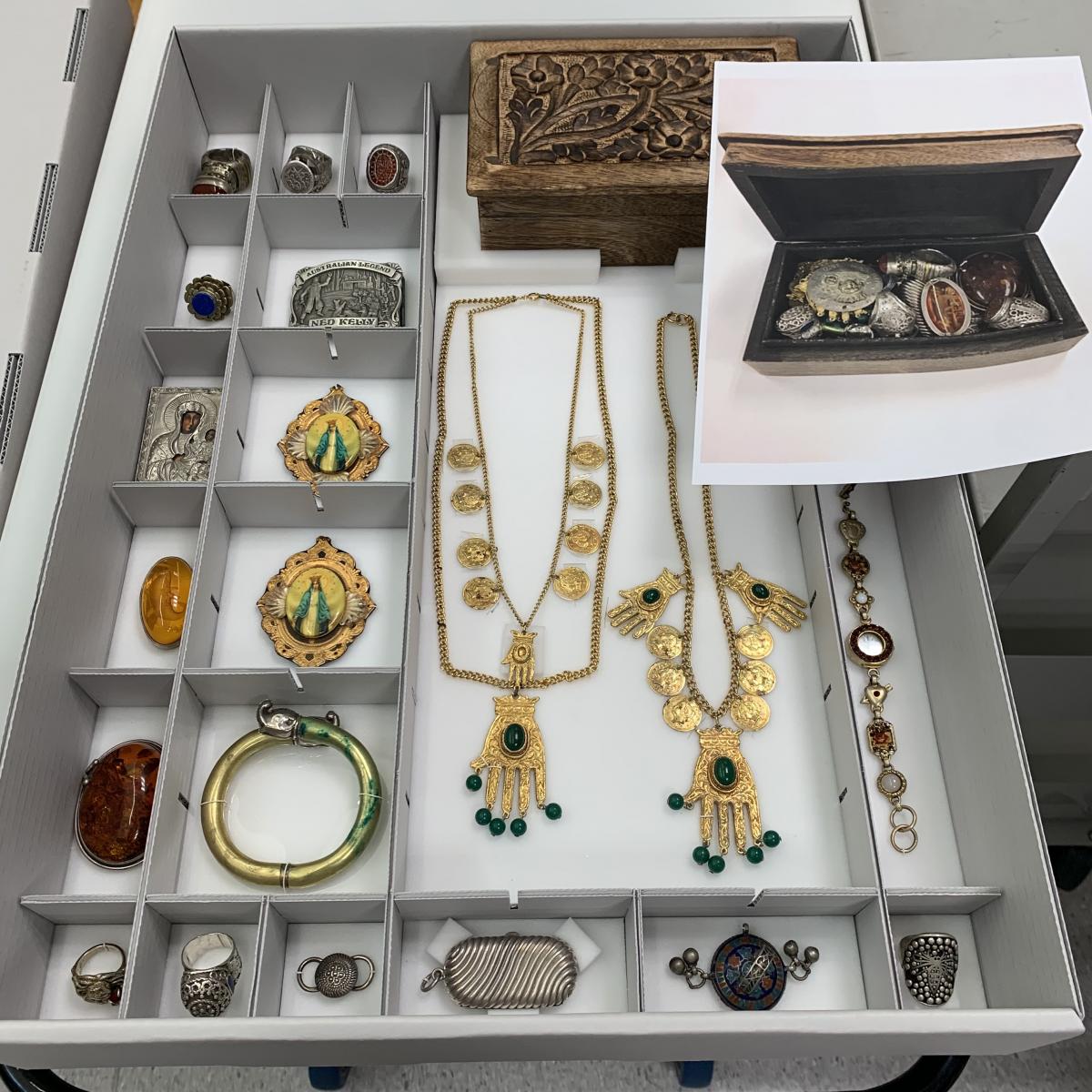
Research projects
Albertine Hamilton and Katy Glen are developing a treatment methodology for the consolidation of two wax paintings by Alice Blanch Chehovski (H2016.42/46-47). An early newspaper describes the technique Chehovski discovered when visiting a kindergarten: ‘The children were dripping candle wax over the surface of a sheet of paper, partly scraping is off, then applying ink’ (A Cooper, 6 March 1985, ‘Limelight for a quiet rebel’, The Melbourne Times: Arts and Entertainment, p. 10). Albertine welcomes any suggestions from conservators with relevant experience.
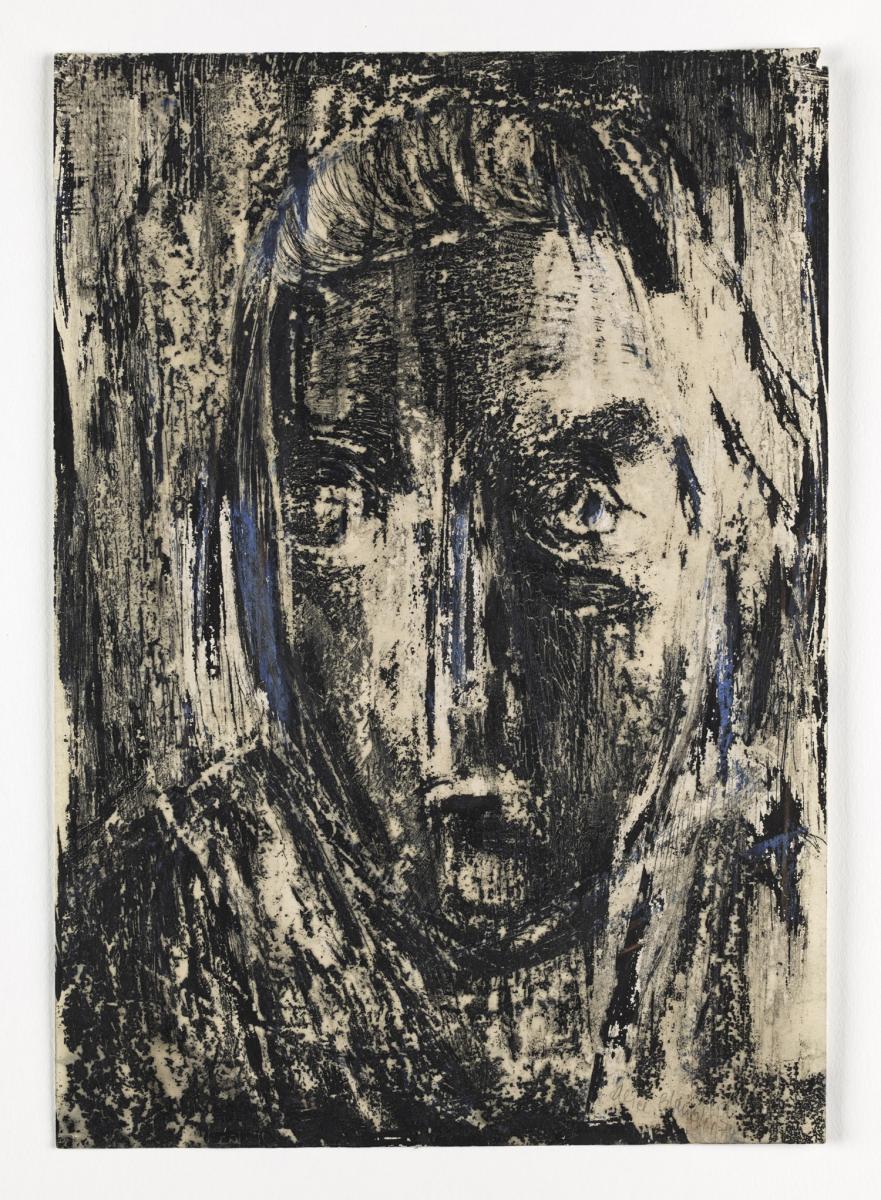
Exhibitions and loans
Our Registrars Sarah Haselton and Fiona Wilson have been managing a variety of inward and outgoing loans. The touring exhibition Self-made: zines and artist books continues its journey this year from Armidale’s New England Regional Art Museum and Murwillumbah’s Tweed Regional Gallery to Toowoomba Regional Art Gallery, where it will open from June.
It has also been officially announced that the Ashes urn will be travelling from the Marylebone Cricket Club at Lord’s, London, to be displayed in the new Victoria Gallery later in the year.
Shelley Jamieson and Amanda Wild have been involved in trialling Fortecho, a new intelligent wireless protection system, and new lighting systems that have been installed in Victoria Gallery.
Workshops, conferences and events
In March, the Conservation Department hosted second-year paper conservation students from the Master of Cultural Materials Conservation at the University of Melbourne. This included a morning with Marika Kocsis learning about Japanese paper and the care and maintenance of Japanese tools. The students also spent a full day with the book conservation team learning about book structures and completing a practical workshop on custom phase box making.
Emily Keppel is currently undertaking a three-month internship in Rome, Italy, with ICCROM. Emily recently published a blog about the ‘zero waste’ initiative for upcoming ICCROM courses, promoting sustainable consumption and production in cultural heritage training.
Tasmania
Tasmanian Museum and Art Gallery
Nikki King-Smith, Object Conservator, showed staff and volunteers from the Army Museum of Tasmania the re-boxed TMAG uniform collection. This has been an ongoing project involving Registration Officer Tamzine Bennett and volunteers Freya Harrington and Alex Jose. Margaret Smith from the Army Museum of Tasmania organised the visit and staff and volunteers were also given a tour of collection areas by Nikki and Cobus van Breda.
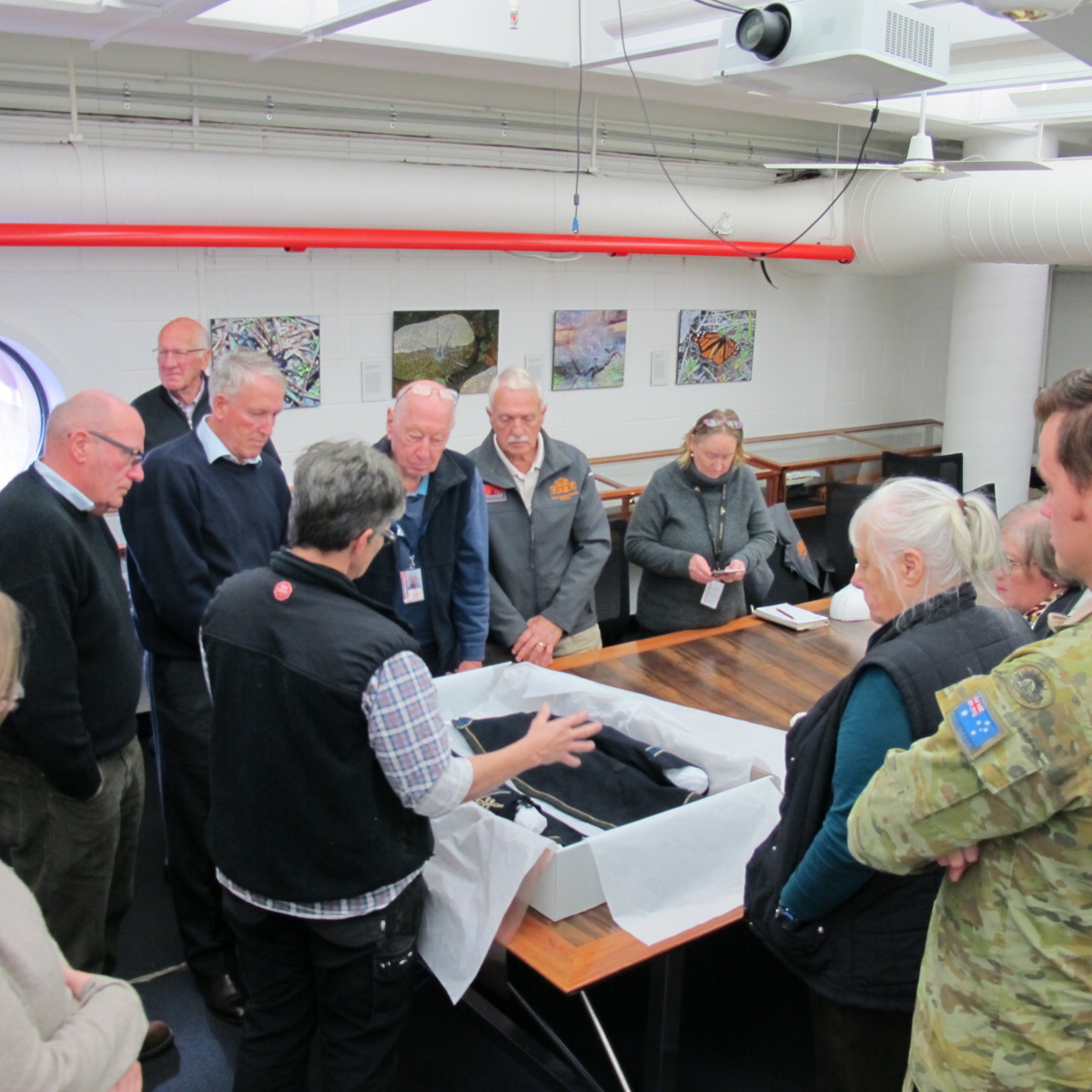

The TMAG conservation labs are being updated. Thanks to Max Strating, Conservation Assistant, Museums Victoria, for including the specs for material roll rack storage in a previous e-news (https://aiccm.org.au/national-news/easy-build-roll-racks). Our very own Registration Officer, Pat Hiller, recreated the design. The rolls are now stored in the corridor and we have more space in the conservation lab!

TMAG’s Conservation Technician, Lisa Charleston, recently completed a project involving the preparation and repair of an unregistered 1840s English gilt frame for use as a component in a digital artwork by Tasmanian Indigenous artist Julie Gough for an upcoming TMAG exhibition, Tense:Past. Lisa was also delighted to attend FRAME: Concept, History and Conservation, Symposium 2, at AGNSW in April.